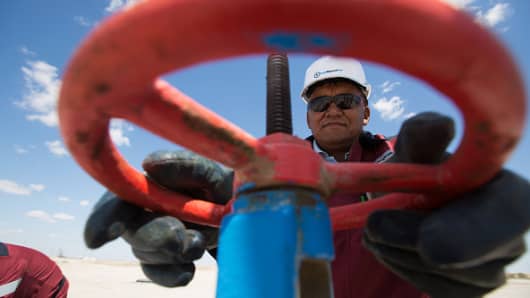Oil not going away as headache for big banks

Sorting out balance sheet issues stemming from prolonged cheap oil could prove to be Wall Street’s greatest challenge in 2016.
On Tuesday, markets and commodities responded positively to the world’s top oil producers’ weighing an output freeze. But that did little to cheer energy investors, and oil slid in intraday trading once more.
Without a sustained rebound in commodity prices, one of the key energy sub-sectors banks watch to evaluate their loan portfolios will continue to founder. It has the potential to hamper major Wall Street banks to varying degrees, as energy exploration and production has been especially hard hit in the U.S.
The debt of energy E&Ps can suffer the greatest short-term impacts of plummeting oil prices because balance sheet projections can be thrown off by violent commodity market fluctuations. They’re often treacherous for banks to invest in, because the loans are backed by assets — to be specific, the oil on E&Ps’ reserves, which has little value to a debtor lacking the equipment, time or the desire to extract commodities and recoup value.
The pace of E&Ps falling into bankruptcy acclerated in the second half of 2015, according to a report Tuesday from consulting firm Deloitte. With oil prices hovering around the $30-a-barrel mark, Deloitte said it is anticipating more defaults, a reduction in dividends and buybacks and more pain for the sector until there is a rebound.
“The industry will have fewer financial levers to pull in 2016,” the report said.
One metric tracking E&Ps shows that the energy production downturn is being especially felt in the U.S.
The global rig count, tracked by Baker Hughes, fell in January to 1,891 from 3,309 a year prior, a 42 percent drop. But the overwhelming majority of the rigs closed are American, highlighting a domestic pullback that outpaces other producers. In the U.S., more than 1,000 rigs were shuttered, representing a decline of 61 percent.
Last quarter, analysts cut expectations for big banks in part based on their exposure to energy debt.
When they reported earnings, many bank executives noted that their portfolio markdowns are only beginning, unless commodity prices rebound. Research from Goldman Sachs shows no bank has created reserves to offset energy loans of greater than 10 percent of their portfolio. Wells Fargo, which has mostly exposure to non-investment-grade debt, has shored up reserves the most, covering more than 6.7 percent of the assumed loans, according to its presentation at the Credit Suisse Financial Services Conference in Florida last week.
As the quarter progresses, a growing number of energy companies’ ratings have slid from investment grade to non-investment-grade, one sector banker told CNBC.com. With data in flux, which energy sub-sector a bank is exposed to may have growing value as an indicator of forward-looking credit costs, he said.
About 40 percent of the $42 billion Wells Fargo is exposed to has been drawn by borrowers already. CFO John Shrewsberry’s presentation last week in Florida highlighted that “extraction” companies (another word for E&Ps) constitute 45 percent of its total exposure to sector loans, which is higher than many of its competitors.
Bank of America, for example, counts 23 percent of its energy loans as being for E&Ps, and the bank has set aside less capital, on a percentage basis, to offset underperformers.
But not every bank has provided as much clarity into their energy lending by sub-sector, instead choosing on earnings conference calls to focus on debt ratings as a potential proxy for portfolio health. If commodity prices remain low, however, debt ratings may serve less as a forward-looking indicator and more as a painful reminder.
[Source:- CNBC]

